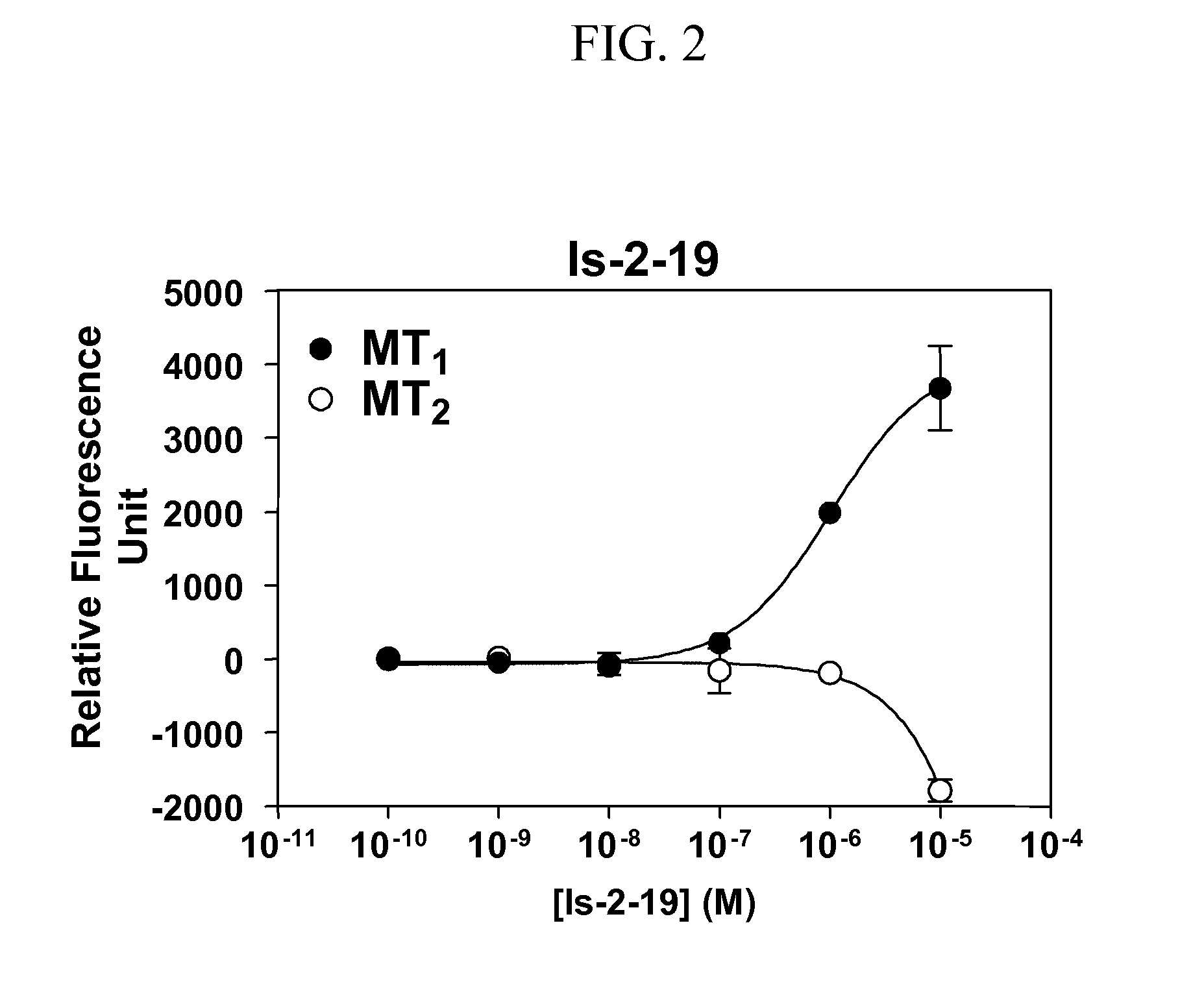Isoquinolone compounds as subtype-selective agonists for melatonin receptors MT1 and MT2
a technology of melatonin receptors and isoquinolones, which is applied in the direction of biocide, drug composition, cardiovascular disorder, etc., can solve the problems of limited clinical application use, poor oral bioavailability, and limited biological half-li
- Summary
- Abstract
- Description
- Claims
- Application Information
AI Technical Summary
Benefits of technology
Problems solved by technology
Method used
Image
Examples
specific examples
Example 1
[0091]
Step 1
[0092]
[0093]To a solution of methylamine in THF (2.0M, 16.8 mL, 33.7 mmol) was added phenyl vinyl sulfoxide (3 mL, 22.4 mmol). The reaction mixture was stirred at room temperature for 18 hours. The solvent was removed under vacuum. The resulting residue was purified by column chromatography to afford the product (2.9 g, 17.1 mmol, 76%).
Step 2
[0094]
[0095]To a solution of the product from step 1 (2.9 g), 4-hydroxy-3-methoxybenzoic acid (3.5 g, 20.6 mmol) and HOBt (2.8 g, 20.6 mmol) in 80 mL dichloromethane under nitrogen, was added diisopropylcarbodiimide (2.6 mL, 20.6 mmol) dropwise. The reaction was stirred at room temperature for 12 hours. The solvent was removed under vacuum. The resulting residue was purified by column chromatography to afford the product (4.8 g, 14.4 mmol, 84%). 1HNMR (400 MHz, CDCl3) δ7.64 (1H, dd, J=8.4, 1.2 Hz), 7.56 (1H, d, J=1.2 Hz), 7.30 (5H, m), 6.93 (1H, d, J=8.4 Hz), 4.49 (2H, t, J=5.6 Hz), 3.92 (3H, s), 3.31 (2H, t, J=5.6 Hz), 2.94...
example 2
[0104]
Step 1
[0105]
[0106]To a solution of methylamine in THF (2.0M, 49.3 mL, 98.5 mmol) was added phenyl vinyl sulphoxide (10 mL, 65.7 mmol). The reaction was stirred at room temperature for 48 hours. The mixture was concentrated under reduced pressure to give a crude product, which was purified by column chromatography to afford the product (8.38 g, 49.5 mmol, 75%).
Step 2
[0107]
[0108]To a solution of the product from step 1 (8.38 g, 45.7 mmol), 3-hydroxy-4-methoxyl-benzoic acid (8.46 g, 50.3 mmol) and HOBt (6.84 g, 50.3 mmol) in a mixture of 150 ml dichloromethane and 40 mL DMF, was added diisopropylcarbodiimide (7.9 mL, 50.3 mmol) dropwise under nitrogen. After stirring at room temperature for 2 days, the reaction was stopped and concentrated under reduced pressure. The residue was treated with dichloromethane. The white urea salt was filtered off. The filtrate was treated with saturated ammonium chloride, extracted with dichloromethane, dried and concentrated to afford 18.83 g of c...
example 3
[0116]
[0117]To a solution of 5-hydroxyl-6-methoxyl-2-methyl-1(2H)-isoquinolone (Product 4 from Example 2, step 4) (40 mg, 0.20 mmol) in 3 mL DMF, was added benzyl bromide (0.035 mL, 0.30 mmol) and potassium carbonate (55 mg, 0.40 mmol). The reaction was stirred at room temperature for 24 hours and quenched by addition of water. The mixture was extracted with ethyl acetate (×3), dried, filtered and concentrated. Purification of the resulting residue by column chromatography afforded the product (45 mg, 76%).
[0118]1HNMR (400 MHz, CDCl3) δ8.20 (1H, d, J=8.8 Hz), 7.35-7.47 (5H, m) 7.14 (1H, d, J=8.8 Hz), 6.94 (1H, d, J=7.0 Hz), 6.67 (1H, d, J=7.0 Hz), 5.07 (2H, s), 3.97 (3H, s), 3.53 (3H, s).
[0119]Using appropriate intermediate (Product 1, 2, 3, 4, 5, 6, 7 or 8) and different bromides (or iodides), the following compounds were prepared according to the procedure outlined in Example 3:
IS007, IS008, IS009, IS010, IS013, IS017, IS042, IS044, IS047, IS521, IS523, IS526, IS528, IS527, IS529,...
PUM
| Property | Measurement | Unit |
|---|---|---|
| volume | aaaaa | aaaaa |
| excitation wavelength | aaaaa | aaaaa |
| time | aaaaa | aaaaa |
Abstract
Description
Claims
Application Information
 Login to View More
Login to View More - R&D
- Intellectual Property
- Life Sciences
- Materials
- Tech Scout
- Unparalleled Data Quality
- Higher Quality Content
- 60% Fewer Hallucinations
Browse by: Latest US Patents, China's latest patents, Technical Efficacy Thesaurus, Application Domain, Technology Topic, Popular Technical Reports.
© 2025 PatSnap. All rights reserved.Legal|Privacy policy|Modern Slavery Act Transparency Statement|Sitemap|About US| Contact US: help@patsnap.com



